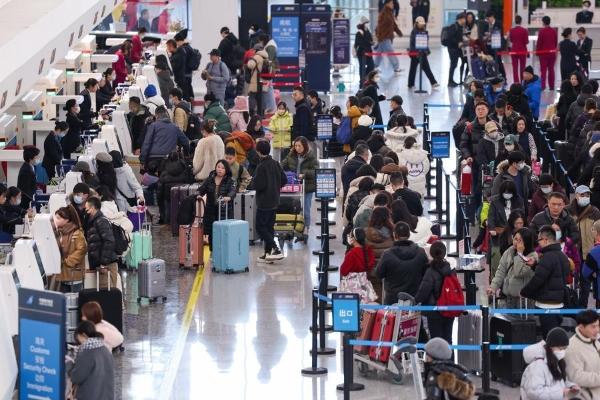
 0 Comment(s)
0 Comment(s) Print
Print E-mail Xinhua, January 27, 2024
E-mail Xinhua, January 27, 2024

Passengers queue up to check in at Beijing Daxing International Airport in Beijing, capital of China, Jan. 26, 2024. [Photo/Xinhua]
China officially ushered in its largest annual population migration on Friday, 15 days ahead of the Spring Festival, or the Lunar New Year, with record-breaking journey numbers expected.
An estimated 9 billion passenger trips are likely to be made during the 2024 travel rush period, according to the country's transport ministry.
Of the total, 7.2 billion trips or about 80% will be made by self-driving, while 1.8 billion trips will be made via railways, highways, waterways, and civil aviation, the ministry said.
China's railway operator on Friday said the country's railways are expected to handle 480 million passenger trips during this travel season, with an average of 12 million trips daily, an increase of 37.9% compared with the previous year. About 10.6 million train trips are expected to be made on Friday, the first day of the travel rush.
The 40-day travel surge, also known as "chunyun," will see hundreds of millions of people return home and reunite with their families and friends.
As a leading indicator of festivities, China's railway system saw a surge in ticket sales, with about 230 million tickets have been sold since Jan. 12, a notable year-on-year increase.
With the record-high migration unfolding, this year's Spring Festival holiday is set to experience not only a stunning number of people flow, but also a vibrant consumption revival boosted by the prosperous tourism market, adding new steam to the country's economic recovery.
Transit in high gear
At 5:34 a.m. on Friday, a high-speed rail journey set off from Beijing West Railway Station, initiating a bustling traffic period during the 40-day festival season in the capital city.
"The normal flow of people is back," said a railway station staff, who was busy checking tickets.

A passenger on train K5207 smooths a window sticker that says "blessing" in Chinese before the train departs from Beijing West Railway Station, Jan. 26, 2024. [Photo by Chen Boyuan/China.org.cn]
According to the China Railway Beijing Group Co., Ltd., the company is expected to handle 39.13 million passenger trips during the Spring Festival travel rush, an increase of 14.1% compared to 2019.
Public transport operators around the country have hunkered down for the upcoming challenges brought by the annual homecoming in epic proportions.
Railway operators decided to arrange 12,700 trains per day leading up to the festival on Feb. 10, and 12,800 trains thereafter. The railway network will be able to handle 14.4% more passengers before the festival and 12.6% more after the festival compared to the pre-pandemic levels of 2019.
The country's airlines planned to add over 2,500 flights during the 40-day period, taking into consideration the likely demand for international trips to popular destinations in Southeast Asia, Japan, the Republic of Korea and other neighboring regions, according to the Civil Aviation Administration of China.
Haikou Meilan International Airport is gearing up for increased activity. According to airport authorities, the airport is expected to handle around 24,708 flights, up 19.1% year on year. These flights are projected to serve around 3.63 million passengers, up 17.5% over the same period last year.
Sanya, Hainan's sought-after tropical destination, expects bustling aviation and tourism activities during the upcoming festival. The Sanya Phoenix International Airport, a key hub in the tropical city, plans to operate 14,700 flights, facilitating the transportation of around 2.86 million passengers.
Cozier, safer journey home
For Jiang Yixiu, a 52-year-old migrant worker who works in Bijie, a city of southwest China's Guizhou Province, this year's chunyun is unforgettable thanks to the advent of a new high-speed railway linking Jiang's workplace and his hometown Libo county.

A police officer beams at a baby passenger inside train K5207 in Beijing West Railway Station, Jan. 26, 2024. [Photo by Chen Boyuan/China.org.cn]
It used to take Jiang more than five hours to return home. Thanks to the high-speed railway, his travel time would be shortened by one hour and travel expense would be cut by one third.
"Compared with other transport means, high-speed trains are more comfortable, allowing me to reunite with my family members without much travel fatigue," he said, adding that he even bought a new suitcase for this trip.
Jiang is among the millions of migrant workers benefitting from the rapid advancement of the country's railway network. Already boasting the world's largest rail network, China in 2023 built 3,637 km of new railway lines, including 2,776 km of high-speed rail.
New technologies and services have also been introduced by the country's railway operators to ensure a smooth and pleasant travel experience for passengers.
China's official railway ticket-booking app 12306 updated its ticket booking system, allowing students and migrant workers to make reservation ahead of the pre-sale date. New services such as food ordering and quiet carriage are now available via the ticket-booking platform to improve the passengers' travel experience.
With more homeward-bound travelers hitting the road, relevant authorities are stepping up efforts to ensure their safety during the trips.
The Ministry of Transport has established a special work team to strengthen the monitoring of and coordination among different transportation sectors such as railway, highway, waterway and civil aviation, as well as ensuring the transport capacity is sufficient to meet demands.
The monitoring of road network operations will also be reinforced, traffic efficiency at toll stations will be improved, and the quality and capacities of service areas will be enhanced, according to the ministry.
Revival of travel frenzy
Aside from the people going home, train stations and departure halls of airports are thronged with eager travelers, pointing to a flourishing travel industry.
On the first day of the travel rush, Guangxi residents Chen Xia and her daughter embarked on their first northward journey to Harbin, capital of northeast China's Heilongjiang Province. They were drawn to travel because of the incredible sceneries they watched via the short-video clips that trended on the social media platforms.

A young girl on board train G6701 waves in Beijing West Railway Station, Jan. 26, 2024. [Photo by Chen Boyuan/China.org.cn]
"I want to see the St. Sophia Cathedral covered by white snow with my own eyes," Chen's 7-year-old daughter Pengpeng said excitedly.
According to research from a major online travel agency Tongcheng, ice-and-snow is the most popular theme for domestic travel, with Harbin the most popular destination for the 2024 Spring Festival holiday.
To woo more visitors, the Harbin railway bureau has put a northeast folk culture-themed train into use, whose carriages are adorned with iconic elements of northeast folk culture, including a typical northeast floral pattern in contrasting red and green colors, offering passengers an immersive journey with themed ambience and services.
Data from China's travel platforms revealed that as of Jan. 21, tourism reservations from Feb. 9 to 17 had skyrocketed by about 7 times from the same period last year.
The passion ignited by the Spring Festival holiday also stimulated unparalleled zeal for outbound travel. As reciprocal visa policies between China and several countries take effect, the outbound tourism sector is poised for a temporary surge during the travel rush. The daily average international and regional passenger traffic at the Beijing Capital International Airport is estimated to be 35,000, with a total expected volume of 1.413 million.
Dai Bin, president of the China Tourism Academy, expects the country's inbound and outbound trips to exceed 264 million visits this year, generating combined tourism revenue of $107 billion.
In his view, domestic tourism, which has recovered rapidly in 2023, is also promising. He predicted that total domestic travel will exceed 6 billion visits in 2024 and that domestic tourism revenue is likely to surpass $844.19 billion.
Go to Forum >>0 Comment(s)